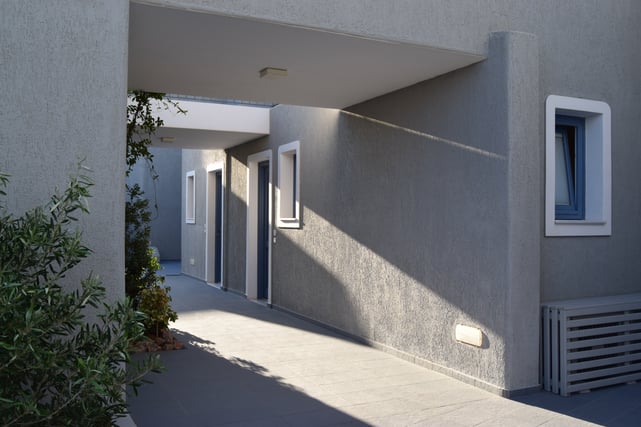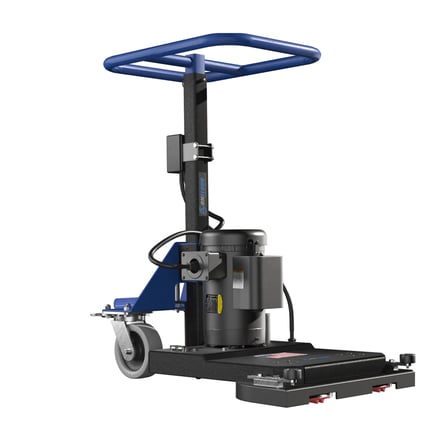Due to its durability and ability to last for years with proper care, concrete is the choice when it comes to industrial floors. However, concrete surfaces can get cracks or fall victim to structural wear as they age.
Substances like acid, fuel, grease, and other debris can weaken concrete- thus making strong coatings necessary. Industrial concrete grinders are a reliable tool for prepping concrete surfaces, creating the perfect surface for coatings to adhere and last.
In this article, we will delve into the numerous benefits of utilizing a multisurface concrete grinder for efficient and effective surface preparation. By exploring the advantages of these cutting-edge tools, you will gain valuable insights into how multisurface concrete grinders can streamline your concrete surface preparation process and deliver exceptional results.
What Is Surface Preparation and Adhesion?
Surface preparation and adhesion are two of the most important factors in any coating process.
Surface preparation involves cleaning, scraping, sanding, etching, or otherwise preparing a concrete surface for the application of coatings or sealants. Adhesion is simply how strongly the coating bonds to the substrate it is applied to.
The Importance of Surface Preparation and Adhesion
When it comes to industrial concrete surfaces, surface preparation is essential. Properly preparing a concrete surface before the application of coatings or sealants ensures that the coating bond and adheres properly, delivering optimal performance and longevity. Without proper surface preparation, coatings may fail due to inadequate adhesion and could cause costly repairs down the road.
One of the most effective ways to prepare a concrete surface is with a multisurface industrial concrete grinder. Industrial concrete grinders are powerful tools designed to quickly and efficiently remove layers of concrete, open the concrete pores and prepare the substrate for coatings or sealants.

What Are Some Other Benefits of Preparing Concrete Surfaces?
In addition to enhancing the performance and longevity of coatings, preparing concrete surfaces also helps protect against environmental damage. A properly prepared and coated concrete floor can resist water infiltration, alkali-aggregate reaction (AAR), and freeze/thaw cycles more effectively than one that is not properly prepared or adhered to. This can help extend the life of the coating and the concrete, preventing costly repairs.
How Concrete Grinders Improve Coating Adhesion
First of all, grinding concrete removes contaminants that may be present on the substrate surface of your concrete, such as oil, grease, and dirt. These contaminants create poor adhesion and a weak bond between coating and concrete. Removing these contaminants is essential for creating a clean surface that will allow for optimal adhesion of coatings.
Second, concrete grinders can be used to level out any surface imperfections that could affect the performance and longevity of coatings. Uneven surfaces can cause coatings to crack or peel prematurely, leading to costly repairs down the road. By leveling these areas with a grinder before coating application, you are setting your surface up for the best possible adhesion and performance.
What Does the Process Look Like?
The process of preparing a concrete surface with multisurface concrete grinders is fairly straightforward. The first step as mentioned, is to clean the surface and remove any contaminants, such as oil, grease, dirt, or debris.
This should be done before using the grinder so that the contaminants are not spread around during grinding. Once this is done, you can begin grinding the surface to create a level and even surface. This is typically done with multiple passes of the grinder, with each pass removing more and more material until an even concrete surface, that is ready for coating is achieved.
What Kind Of Grinder Should I Use?
When it comes to selecting the right grinder for your surface preparation needs, there are a few things to consider.
You may want to consider a grinder with variable speed control, which can help prevent gouging or otherwise damaging the surface.
Grinders such as Onfloor's OF16Pro are designed to quickly remove material while also delivering superior results in terms of adhesion, performance, and longevity.
- Look for a grinder that is powerful enough to quickly and efficiently remove material.
- Consider a grinder that has special features such as dust collection or integrated vacuums, which can make cleanup easier.
.jpg?width=700&height=407&name=Spectrum%20Owasso%20repair%204%20(1).jpg)
FAQ's
How do I know if a concrete grinder is suitable for my project?
The answer to this question will depend on the size and scope of your project. Multisurface concrete grinders are designed for larger, commercial-scale construction projects that require high levels of surface preparation.
This includes:
- Restaurants and Food Service Commercial Structures
- Medical Facilities Construction.
- Office Building Commercial Construction.
- Hotels and Other Lodging.
- Industrial Building Construction.
- Sports Facilities.
- Large-Scale Institutions.
These machines can be used to grind away layers of concrete, making them ideal for preparing surfaces before applying either coatings or sealants. It is important to select a machine that is suitable for the size and scope of your project, since using an undersized or oversized machine can lead to suboptimal results.
Additionally you’ll want to consider factors such as:
- Power
- Job size
- Budget
- Site accessibility
What type of coatings can be applied after using a concrete grinder?
Most types of coating or sealant can be applied after a concrete grinder has been used to prepare the surface. It is important to select the right product for your application and to follow all safety instructions provided by the manufacturer. Additionally, we recommend that you thoroughly clean any areas before applying coatings so that you can achieve optimal adhesion. Common coating options include acrylics, urethanes, paint and epoxy.
How do I ensure good adhesion when applying coatings?
Good adhesion is essential for ensuring optimal performance and longevity of coatings. To achieve the best possible chemical adhesion, you need to start with a good concrete surface profile prepared with an industrial concrete grinder.
By removing contaminants and leveling any imperfections, you are creating a substrate that will allow the coating to bond properly and achieve strong adhesion. As with all projects, you’ll need to follow all safety instructions provided by the coating manufacturer to ensure the safe application of any coatings.
Are there any safety considerations when using a concrete grinder?
Yes, you need to take several safety considerations into account when operating an industrial concrete grinder. It is important to always wear protective gear (such as eye protection, gloves, and a dust mask) when operating the machine.
Additionally, it is important to ensure that the area around the grinder is kept clear of dust by using proper filtration pieces. Finally, it is important to read and follow all instructions provided by the manufacturer to ensure safe operation of the machine.

What is the best way to maintain and store industrial concrete grinders?
Maintaining and storing industrial concrete grinders is essential for ensuring optimal performance over their lifespan. You need to regularly inspect the machine for any wear and tear, as well as clean out any dust or debris that has built up in the machine or around the area with a vacuum. On top of that, it is important to store the machine in a dry and temperature-controlled environment when not in use.
How long does surface preparation take?
The amount of time needed for surface preparation will depend on the size and scope of the project. Generally speaking, larger projects can take several hours or even days to complete, while smaller projects may be completed in less than an hour.
With the 20Pro in particular, you can prepare more than 600 square feet per hour of concrete per grit on a single phase 208-240V power.
Additionally, you’ll have to consider coating dry times for coating jobs. With a polishing job on the other hand you’ll want to follow these steps to ensure a quick process.
What if I don't complete surface preparation?
Failing to properly prepare a surface before coating can lead to suboptimal results through poor bonding and even damage. If coatings fail, moisture and chemicals can seep into concrete causing cracking and long-term structural damage
In addition, any contaminants on the surface will be sealed in by the coating and can cause issues such as bubbling or chipping over time. Therefore, it is essential that you take the time to properly prepare any surface before coating. After all, coatings are also expensive, so it is best not to be wasteful if you're on a budget.
Conclusion
Surface preparation is a critical step in ensuring the longevity and performance of applied coatings. Industrial concrete grinders are an essential tool for coating concrete surfaces.
By selecting the right grinder, as well as following all safety instructions, you can quickly and easily create an optimal surface profile and adhesion. Furthermore, proper storage and maintenance of the grinder will help to ensure its longevity over time.
By taking the time to complete surface preparation with an industrial concrete grinder, you can rest assured that your coatings will look great, work as designed, and last longer
Have questions about concrete grinding? Be sure to check out the rest of our blog, which is filled from top to bottom with expert advice. When you’re ready to take your concrete grinding capabilities to the next level, our team at Onfloor is always ready to help.
0 comments